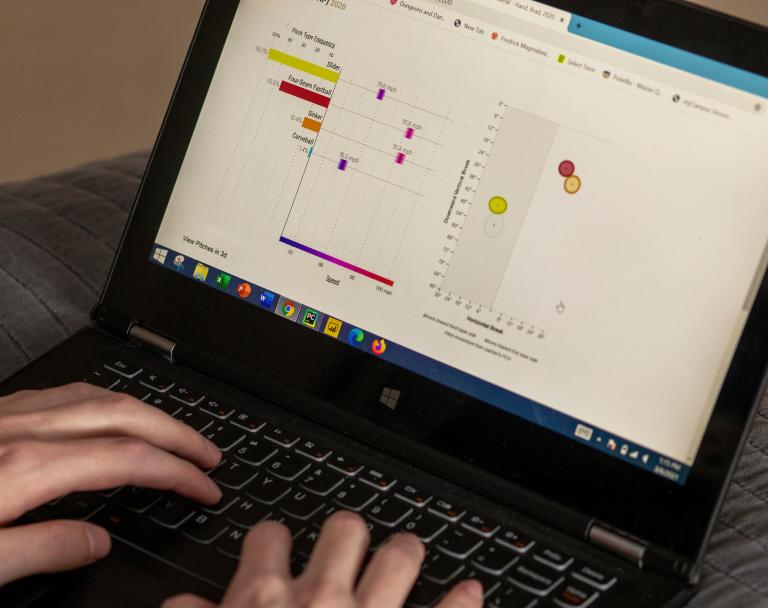
In our data-driven world, businesses are constantly collecting large amounts of data. But how can they turn this data into actionable insights that drive growth and success? This is where business analytics comes in. Business analytics refers to the “process of [providing] better decision-making by analyzing data or information, ” explains Wei Chen, PhD, Associate Professor of Business Analytics at York College of Pennsylvania. It involves using various tools and techniques, such as data mining, predictive analytics, and data visualization, to make informed decisions that help businesses achieve their goals.
Today's rapidly changing business landscape makes data-driven decision processes more critical than ever. Companies need to collect, analyze, and interpret large amounts of data to stay competitive, reduce risk, and identify growth opportunities. Business analytics help organizations to gain a competitive edge by allowing them to make choices grounded in real-world evidence. “Every business domain – finance, accounting, information systems, cyber security, supply chain – [are] all supported by data,” Dr. Chen says.
The Importance of Data-Driven Decisions
In today's business environment, making data-driven decisions is crucial for success. Companies must be able to collect, analyze, and interpret large amounts of data to stay ahead of the competition. With the rise of big data, businesses can now collect vast amounts of information on customers, operations, and competitors.
The ability to analyze and interpret this data can provide valuable insights into:
- Customer Behavior
- Operational Efficiency
- Overall Business Performance
In the past, decision-making was often based on intuition or experience. However, this approach is no longer sufficient in today's data-driven world. Companies that make data-driven decisions are more likely to succeed and stay ahead of the competition. A McKinsey study on data-driven decision-making showed that organizations using this approach were nineteen times more likely to be profitable, six times more likely to retain customers, and twenty-three more times likely to acquire new business compared to their counterparts who do not employ data-driven decision-making. Business analytics allows organizations to gain insights into their operations, customers, and competitors, enabling them to make informed decisions that reduce risk, save time and money, and identify opportunities for growth and expansion.
The Basics of Business Analytics
To begin with, companies must collect and process data from various sources, including internal systems, customer interactions, and market research. This data is then analyzed using various techniques to identify patterns and trends that provide valuable insights. Data collection and processing are crucial to the success of business analytics. Data can be collected from various sources, including customer interactions, social media, surveys, and sales data. Once collected, data must be processed to remove errors, inconsistencies, and duplications.
Once data has been collected and processed, various techniques can be used to analyze and interpret the data. Data mining is one such technique that involves using statistical algorithms to identify patterns in large datasets. Predictive analytics, on the other hand, uses historical data to predict future trends and behaviors. Data visualization tools help to present data in a visual format, making it easier to understand and interpret. Several tools and software are commonly used in business analytics, including “Microsoft Excel, Tableau, Power BI, and Python,” Dr. Chen explains. These tools provide businesses with a range of features, including data visualization, predictive analytics, and data mining.
Types of Business Analytics and Data Applications
Understanding customers' behavior, preferences, and needs
By analyzing customer data, businesses can gain valuable insights into their behavior, preferences, and needs. This can help them develop targeted marketing campaigns, improve customer engagement, and ultimately drive sales.
Example: By analyzing customer data, a retailer may discover that a particular demographic prefers to shop online, and therefore focus their marketing efforts on digital channels.
Making data-driven decisions to reduce risk and save time and money
Business analytics can help organizations make informed decisions based on data, rather than relying on guesswork or assumptions. By using data analytics tools such as business intelligence, data visualization, and predictive analytics, businesses can identify trends and patterns, and make decisions that reduce risk and save time and money.
Example: A manufacturing company may use predictive analytics to forecast demand for their products, allowing them to adjust production levels and inventory accordingly.
Identifying opportunities for growth and expansion
Through data analysis, businesses can identify new opportunities for growth and expansion. By identifying gaps in the market or new customer segments, businesses can develop new products and services that meet these needs, and gain a competitive edge.
Example: A restaurant chain may use data analytics to identify which menu items are most popular in different locations, and adjust their offerings accordingly.
Improving operational efficiency and competitiveness
By analyzing operational data, businesses can identify inefficiencies and areas for improvement. This can help them streamline their operations, reduce costs, and improve their competitiveness.
Example: A logistics company may use data analytics to optimize their delivery routes, reducing fuel costs and improving delivery times.
Managing risk and improving resilience
Business analytics can help organizations manage risk and improve resilience. By analyzing data on factors such as market trends, customer behavior, and supply chain disruptions, businesses can identify potential risks and take proactive measures to mitigate them.
Example: A financial services company may use data analytics to detect fraudulent activity, helping to reduce the risk of financial losses.
Careers in Business Analytics
Careers in business analytics are becoming increasingly popular as more and more businesses recognize the value of data-driven insights.
There are a variety of roles within the field of business analytics, including:
- Data Analysts
- Data Scientists
- Business Intelligence Analysts
- Predictive Analysts
Education Requirements and Qualifications for Business Analysts
To pursue a career in business analytics, a strong background in mathematics and statistics is typically required. Many professionals in the field hold a bachelor's or master's degree in Business Analytics, Data Analytics, or a related field such as statistics, mathematics, computer science, or engineering. In addition to educational qualifications, candidates for business analytics roles should also possess strong analytical skills, critical thinking abilities, and an aptitude for problem-solving.
Some specific qualifications that may be required for certain business analytics roles include experience with:
- Data Mining
- Predictive Modeling
- Data visualization software such as Tableau, SAS, and R.
- Knowledge of programming languages such as Python, Java, and SQL may also be beneficial, as well as familiarity with big data platforms such as Hadoop and Spark.
In addition to technical qualifications, business analytics professionals should also possess strong communication and collaboration skills, as they will often be required to work closely with colleagues in other departments such as marketing, finance, and operations. Being able to effectively communicate complex data insights to non-technical stakeholders is a key skill in many business analytics roles.
Explore a bachelor’s degree in Business Analytics from York College of Pennsylvania.
The Future of Business Analytics
The future of business analytics is bright, as advancements in technology and an increasing focus on data-driven decision-making are expected to drive continued growth and innovation in the field.
One major trend in the future of business analytics is the continued growth of big data. As more and more data is generated by businesses, governments, and individuals, the need for advanced analytics tools and techniques to make sense of that data will only continue to grow. This is likely to lead to the development of new and more sophisticated analytics software and platforms, as well as the need for skilled data scientists and analysts to analyze and interpret the data.
Data Privacy and Artificial Intelligence in Business Operations
Another trend in the future of business analytics is the increasing importance of data privacy and security. With the increasing amount of data being collected and analyzed, businesses will need to ensure that they are protecting that data from unauthorized access and use. This is likely to lead to the development of new security measures and technologies, as well as a growing demand for professionals with expertise in data privacy and security. This is where cybersecurity comes in. “Cybersecurity is one of the most important business domains for data analytics and is essential to secure data for any institution,” Dr. Chen says.
Additionally, the future of business analytics is likely to be shaped by advancements in machine learning and artificial intelligence (AI). These technologies have the potential to transform the way that businesses analyze and use data, enabling more sophisticated and automated analysis and decision-making. This is likely to lead to the development of new analytics tools and platforms that incorporate machine learning and AI, as well as the need for skilled professionals with expertise in these areas.
Learn more about the Business Analytics degree program at York College of PA.




